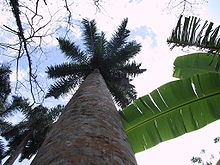Royal palm
| Royal palm | ||||||||||||
|---|---|---|---|---|---|---|---|---|---|---|---|---|

Royal Palm ( Roystonea regia ) |
||||||||||||
| Systematics | ||||||||||||
|
||||||||||||
| Scientific name | ||||||||||||
| Roystonea regia | ||||||||||||
| ( Kunth ) OFCook |
The royal palm ( Roystonea regia ) is a native to the Caribbean plant species from the family of palm family (Arecaceae). It is a widespread ornamental plant in tropical and subtropical areas .
features
The trunk is up to 20 m, rarely up to 30 m high with a diameter of 37 to 57.5 cm, the surface is gray-white. The crown consists of around 15 leaves . The lowest leaves hang down below the horizontal. As with all members of the genus, the crown shaft is strikingly green and around 2 m long. The petiole is up to 50 cm long , the rhachis around 4 m long. The middle leaflets are 63 to 119 cm long and 2.5 to 4.6 cm wide.
The inflorescence is around 1 m long and just as wide. The cover sheet is about 36 cm long and 7.3 cm wide, the bract on the inflorescence stalk is 0.8 to 1.6 m long and 9.8 to 13 cm wide, the widest in the middle. The side branches of the inflorescence are 11 to 31 cm long and 0.9 to 2.3 cm in diameter. The male flowers are white. The sepals are triangular, 0.8 to 1.4 mm long and 0.9 to 2 mm wide. The petals are elliptical to oval, 2.5 to 6.4 mm long and 2.2 to 3.5 mm wide. There are 6 to 9 stamens that are 3.2 to 7.5 mm long. The stamens are awl-shaped and 2.3 to 5.6 mm long, the anthers are 2.4 to 4.5 mm long. The stamp rudiment is very small. The female flowers are also white, the sepals are kidney-shaped, 0.7 to 1.8 mm long and 1.8 to 3.4 mm wide. The petals are oval and 2.7 to 3.7 mm long. The staminodes are six-lobed, 1.3 to 2.8 mm long and fused in the lower part. The gynoeceum is 1.1 to 3.5 mm long with a diameter of 0.9 to 2.6 mm.
The fruits are spherical to ellipsoidal and somewhat compressed dorsiventrally. They are 8.9 to 15.1 mm long, dorsiventrally 6.9 to 11.2 mm thick and 7 to 10.9 mm wide. The exocarp is purple-black, the remnant of the scar is flat. The endocarp is ellipsoidal and 7.5 to 11.1 mm long.
Distribution and locations
The royal palm grows in the hills and valleys of Cuba . In Florida it occurs in the counties Collier, Dade and Monroe and grows here on the hammocks of the Everglades , small elevations made of limestone. Other natural occurrences can be found on the Yucatán Peninsula and on the Gulf Coast of Mexico , in Belize and Honduras , as well as on the Cayman Islands , possibly also in the Bahamas. The species is widely planted in the tropics and subtropics worldwide and easily grows wild or becomes naturalized. Such populations, derived from cultivated stocks, were often considered indigenous, for example in Panama, Costa Rica or Guyana.
Systematics
The nomenclature of Roystonea regia is complicated, a number of synonyms have been published. Roystonea regia was first described by Karl Sigismund Kunth in 1816 as Oreodoxa regia , in the first volume of the Nova genera et species plantarum published by Alexander von Humboldt , Aimé Bonpland and Kunth . The species was transferred to the new genus Roystonea in 1900 by orator Fuller Cook .
Florida populations have long been known as a distinct species, Roystonea elata . This name goes back to William Bartram , who described a Palma elata in 1791 . According to the rules of nomenclature , this name would have priority, however, due to the widespread use of the name was Roystonea regia this or its basionym Oreodoxa regia over Palma elata preserved .
use
In Cuba, the royal palm is used for timber, the leaves for roofing and the fruits as pig feed. It is planted as an ornamental plant in the tropics and subtropics around the world. It is considered to be the most commonly cultivated ornamental palm.
supporting documents
- Scott Zona: Roystonea (Arecaceae: Arecoideae). In: Flora Neotropica. Volume 71, 1996, pp. 1-35 ( JSTOR ).
Individual evidence
- ^ Vienna Code of the ICBN, Appendix III E , accessed September 29, 2009.
Web links
- Description in the Flora of North America (English)
- Profile (English)

